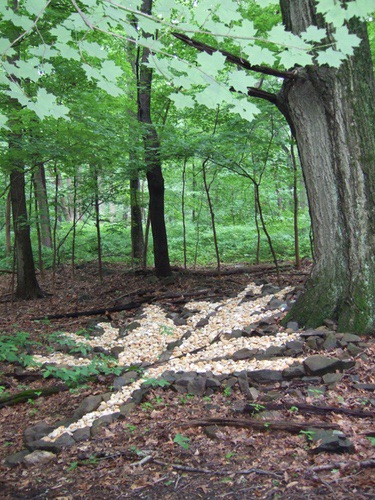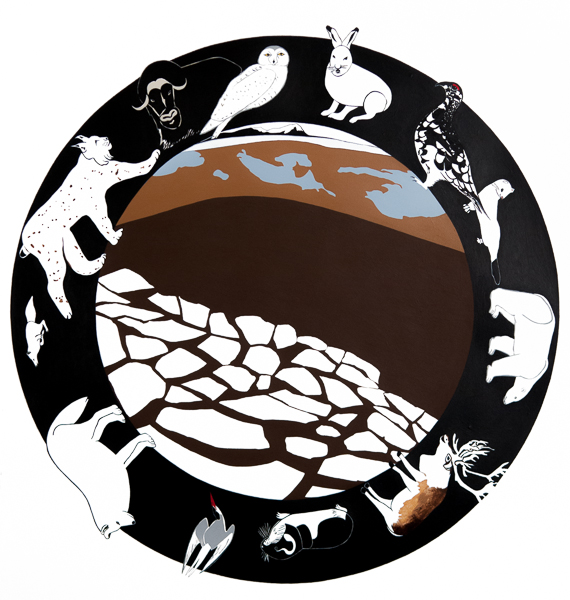
Introduction
Susan Hoenig was born in Hartford, Connecticut in 1954 and resides at Mountain Lakes Preserve in Princeton, New Jersey. Hoenig connects Earth and Art to present the relationship between habitat, plant, and animal life. Hoenig is an ecological sculptor and painter and received a B.A. from Bennington College and an M.F.A. from the University of Iowa. She is now a teacher at Princeton University. At Princeton, Hoenig works alongside friends of Princeton Open Space to draw attention to the beauty of native trees. She also works at the Featherbed Lane Bird Banding Station in the Sourland Mountains of New Jersey. Hoenig has received honors in the field she loves. Susan Hoenig contains a strong passion for all kinds of nature on Earth and by sculpting and painting, she’s able to make people aware of the ecological problems and concerns within them. Her artworks express a social change in the world and to make everyone aware that climate change is a much larger deal and will continue to affect plants and wildlife all around us.
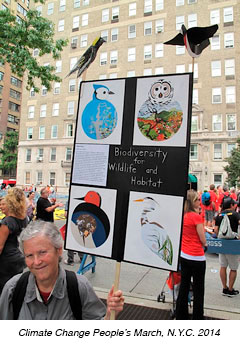
Ecological Sculptured (Earthwork)
Susan Hoenig’s works caters to the spiritual aspects of nature. She uses her art as a way of showing all the indescribable aspects of nature that people don’t usually think about. She is no stranger to using what’s around her to aid in the creation of her pieces. One Of the most objects that she uses to create her projects is stones or rocks. Besides using stones to create the leaf sculptures she also uses them to help her create her ecological sculptures, which she refers to as an earthwork. There is a total of 11 sculptures within this project. She describes her earthworks as sculptural pathways.
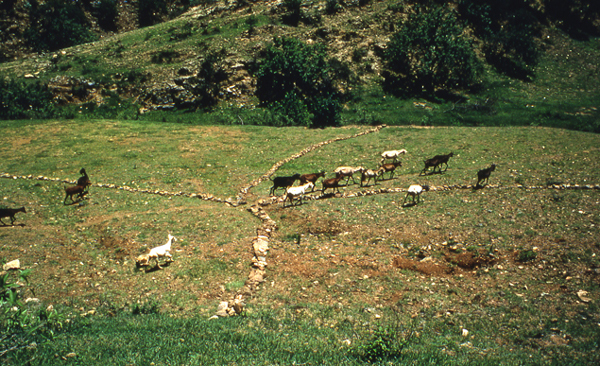
She was inspired to create the sculptures after working with an artist called Paolo Soleri in 1979 in the Desert Mesa of Arizona. During this session, she watched as he created molds from the earth using homemade concrete. Due to that experience, she stopped painting for a bit and started to work with nature. This led to Her first ecological sculpture, which is called stone crossing. This sculpture was her first large-scale earthwork. One of the sculptures is located in Oaxaca, Mexico, and was based on the indigenous people and their process of outlining their living spaces. She describes this as “was a place where I could observe the changes in nature, the changes in light at different times of the day, connecting myself to the earth.”
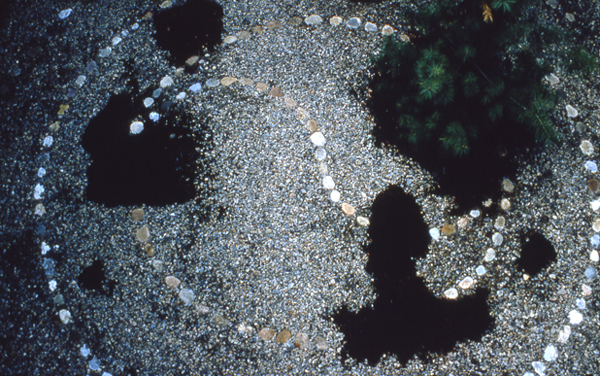
Another sculpture within this collection is called spring Earthwork. This is a courtyard installation in the Brockton museum in Brockton Massachusetts and was created to celebrate the spring equinox. She created this piece in 1982 and created it to heighten peoples’ awareness of the environment and their involvement. Another sculpture within this collection is called spring Earthwork. This is a courtyard installation in the Brockton museum at Brockton Massachusetts and was created to celebrate the spring equinox. She created this piece in 1982 and created it to heighten peoples’ awareness of the environment and their involvement.

The third piece is called Earth Energy Lines and was created in 1983. She was dowsing the stone walls and discovered a large bolder that. This bolder was the center spot and connected the six lines. Using the rocks she found she traced the invisible lines. Within this piece, the Lines are linked to a network of patterns and created an invisible geometric that used to exist.
Biodiversity Bird Paintings
Susan Hoenig has created works of many bird paintings over the years and claims to still paint more even today. She has painted more than 20 bird paintings that are all shown on her personal website where the rest of her works are. Susan Hoenig’s love for nature has continuously inspired her to paint birds that include what she sees as she explores different parts of nature throughout her life. With her bird paintings, Susan Hoenig uses acrylic paint for these particular works and does it on paper. A few of her bird paintings were the Spicebush, Painting Poison Ivy, and The Wood Thrush and the Land Snail.
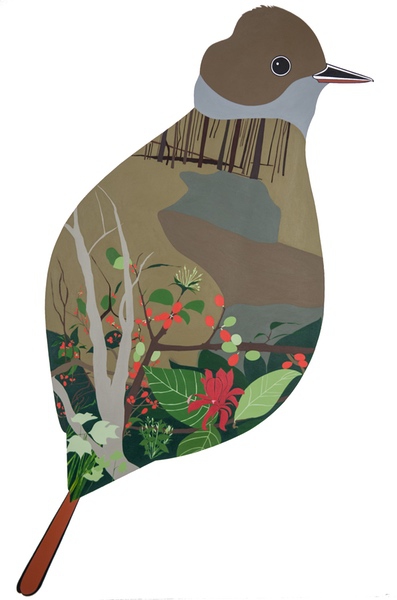
The Spicebush(2010) painting was named after the plant Susan Hoenig had planted in 2010 during the drought in the Sourland Mountains. According to Susan Hoenig, she said, “It was the year of a drought, great drought, we carried saplings, 12 saplings of Spicebush…” Susan Hoenig and a colleague from the Featherbed Lane Bird Banding station decided to plant Spicebush in a part of the forest in the Sourland Mountains because there was nothing but leafless trees. In addition to that, this was also a restoration project Susan Hoenig was in and because this plant is being consumed by deer all the time, Susan decided to help with planting this in the forest. Susan Hoenig decided to paint what she and others planted, the Spicebush, with the background of the leafless trees and the empty ground around the plant, as well as the Invasive Japanese Stiltgrass growing all around it. The bird in the painting is the Great Crested Flycatcher and Susan Hoenig used this specific bird because it eats the berries from the Spicebush plant.

Painting Poison Ivy is a different sort of bird painting of Susan Hoenig’s because there are two birds inside of the same painting, which consists of a type of bluebird and a Yellow-rumped warbler who are near the poison ivy berries they both eat. Moreover, Susan Hoenig incorporated the plants surrounding the two birds and gave her own choice of colors to the leaves as she claims these kinds of plants turn different colors during a certain time when the weather changes. Susan claims to have always gotten poison ivy so many times growing up, hence the title of this work and the white poison ivy berries.
“The ‘Queen of the Night’s Aria’ permeated the forest. Palette in hand, I painted hues of greens, pinks, oranges and bright reds. The colorful leaves shone brightly between the sun and the moon. In a quickening moment, at the highest note, I finished the hairy vines climbing toward the light. I painted berries green, as if in a dream. They turned white, then cream-white. They were ready. The magic flute announced completion. The birds came at once to feast. I touched up leaves brownish yellow. Then winter came and all the berries were gone, in the forest of poetry.”
Susan Hoenig

This is another type of work by Hoenig, to which the Wood Thrush(outside) is presented with its food, the White-lipped land snail(inside), which is surrounded by the leaves and plants. Susan Hoenig’s reason for painting this particular snail on the inside of this bird is because these types of snails are the Wood Thrush’s prey. Unfortunately, the Wood Thrush species is declining, according to Susan Hoenig, because the land snails are declining as well because of the decrease of nutrients within the soil they consume. Thus, the symbolism of painting a rapidly declining food chain represents how climate change has impacted these particular species and their food as a whole.
Climate change has been affecting the birds mentioned above and some of the food they eat because like the land snail, it’s population is declining because of the acid rain that’s reducing the amount of calcium in the soil they eat, thus causing the Wood Thrush species to decline because of this connection. Overall, though, Susan Hoenig’s passion for nature is presented all throughout each of her bird paintings and she incorporates her view of these parts of the forest specifically to express her inspirations, as well as explain why she chose to paint these birds and areas on the topic of ecological issues.
“Since 2006, I have been working with a bird bander/biologist in the Sourland Mountains of New Jersey. I see first hand the life cycle of birds and the conditions and habitat in which they live. In my Songbird Paintings, I explore the union of my inner self with the birds that I observe. I become one with the bird, then I paint their portrait. The body encompasses the circle; at the center a luminous quality of color interplays with the form. The designs create a self-reflective movement…This very personal experience integrates a sad truth of a life interrupted.”
Susan Hoenig
Bibliography
- Hoenig, Susan. “Biodiversity Paintings.” Accessed December 10, 2020. http://www.susanhoenig.com/biodiversity-paintings/biodiversity-paintings-index.html.
- Bilodeau, Chantal. July 21, 2014. “Connecting Earth and Art.” Accessed December 10, 2020. https://artistsandclimatechange.com/2014/07/21/connecting-earth-and-art/
Working With Leaves
Alongside her interest in birds, Susan Hoenig also has a deep fascination with leaves. She first began collecting them when she would go bird watching. As the birds hid in bushes or flew above her, the leaves surrounded her. One unique kind of leaves that she spent most of her time with was the Leaf Miner leaves. These leaves had insects that would lay their eggs inside the leaf, between the epidermal layers, creating a white/yellow swirl design. Hoenig painted many variations of these leaves, 25 of which were being displayed at the Monmouth Museum but recently closed due to COVID.
Hoenig has also spent her time creating Ecological Leaf Sculptures. Amongst the trees, marshes and meadows in Graeber Woods, New Jersey, lie giant leaves made up of stones. Since 2016, Hoenig has been collecting rocks from the nearby area and from quarry donations to use for her sculptures. They rest right below trees such as oak, black walnut, bigtooth aspen, American beech, and sassafras, mimicking their leaf designs.
Hoenig leads walking tours through these woods, teaching valuable information she has learned about the forest throughout the years. “One large tree can provide enough oxygen for four people.”, she mentions in hope that individuals can feel more connected with nature. Hoenig visits the site often during different seasons to observe the changes. When it nears the spring, scarce flowers bloom around her black walnut sculpture that are often eaten by dear. During fall, the sculpture gets flooded with black walnut that Hoenig collects to create ink for her other artworks.
Left; Red Oak Leaf Sculpture June 2017, Center; Black Walnut Leaf Sculpture April 2018, Right; Sassafras Leaf Sculpture July 2017, Graeber Woods Preserve Frankin Township, New Jersey, Susan Hoenig
“I try to say things I’ve learned about so people can really connect themselves to the forest and see why the forest is so important. This relationship between humans and their environment and how it sustains them. And of course, I feel how we should sustain them, the trees and the forest.”
Susan Hoenig
